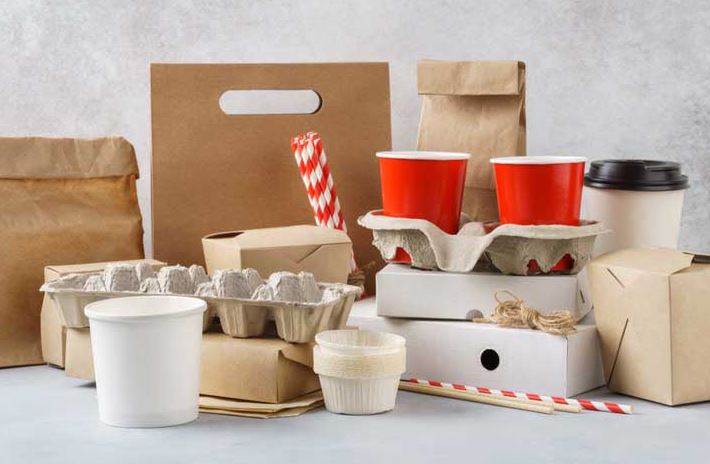In recent years, the negative impact of single-use plastics on the environment has come into sharp focus. As a result, there is a growing demand for eco-friendly packaging materials that can help reduce waste and minimize the ecological footprint of the food industry.
Read this informative article by one of the best tin box manufacturers –
Paper-based Packaging
Paper-based packaging is a widely recognized alternative to single-use plastics. It is derived from renewable resources and is biodegradable and recyclable. Materials such as paperboard and corrugated cardboard are commonly used for boxes, cartons, and sleeves. Additionally, advancements in technology have led to the development of water-resistant and grease-resistant paper coatings, expanding the range of applications for paper-based packaging.
Biodegradable and Compostable Materials
Biodegradable and compostable materials offer an eco-friendly alternative to traditional plastics. These materials are designed to break down naturally and quickly without leaving behind harmful residues. It’s important to note that while these materials offer environmental benefits, proper waste management infrastructure is necessary to ensure they are effectively composted and do not end up in landfills or contaminate recycling streams.
Plant-based Plastics
Plant-based plastics, also known as bioplastics, are derived from renewable biomass sources such as corn, sugarcane, or vegetable oils. These plastics have similar properties to conventional plastics but are designed to be more sustainable. They can be used in various packaging applications, including bottles, trays, and films.
Edible Packaging
Edible packaging represents an innovative and sustainable approach to reducing waste. It involves using edible materials, typically derived from plant starches, proteins, or seaweed, to create packaging that can be consumed along with the food it contains. Edible films and coatings can be used for items like individually wrapped snacks or single-serve portions. While still in the early stages of development and adoption, edible packaging shows promise in reducing plastic waste and offering a unique and eco-friendly consumer experience.
Tin containers for food packaging
When it comes to food packaging, the choice of materials plays a crucial role in preserving product quality and ensuring consumer satisfaction. One material that stands out for its numerous advantages is tin. Tin containers for food packaging have been used for centuries, and they continue to be a popular choice for various reasons.
Importance of Eco-Friendly Packaging Materials
Conservation of Resources
Eco-friendly packaging materials help conserve valuable natural resources. By opting for materials that are renewable or derived from recycled sources, we reduce the demand for virgin materials, such as plastic or paper made from trees. For example, using recycled paper for packaging saves trees and reduces energy consumption and water usage compared to producing new paper.
Reduction of Environmental Impact
Traditional packaging materials, especially single-use plastics, have a significant detrimental impact on the environment. They contribute to pollution, waste accumulation in landfills and oceans, and the release of greenhouse gases during production and disposal. Eco-friendly packaging materials help mitigate these environmental concerns. For instance, biodegradable materials break down naturally, reducing the persistence of waste in the environment.
Consumer Perception and Brand Reputation
The growing awareness and concern for environmental issues have led consumers to prioritize sustainable practices and products. Packaging that is perceived as eco-friendly reflects positively on brands and helps build a strong reputation. Businesses that embrace eco-friendly packaging materials demonstrate their commitment to environmental stewardship, resonating with environmentally conscious consumers. By aligning with consumer values and addressing their sustainability concerns, brands can enhance customer loyalty, attract new customers, and differentiate themselves in the marketplace.
Regulatory Compliance and Market Access
Governments worldwide are implementing stricter regulations and standards to curb the use of environmentally harmful packaging materials. By embracing eco-friendly packaging materials, businesses can ensure compliance with these regulations and avoid penalties and legal issues. Moreover, many retailers and e-commerce platforms have established guidelines or preferences for sustainable packaging, making it a requirement for suppliers to meet certain environmental criteria. By adopting eco-friendly materials, businesses can access these markets, expand their customer base, and strengthen their partnerships with retailers.
Conclusion
As the detrimental effects of single-use plastics become increasingly evident, the demand for eco-friendly packaging materials continues to rise. Paper-based packaging, biodegradable and compostable materials, plant-based plastics, and edible packaging are just a few alternatives that offer greener options for the food industry. Embracing these sustainable alternatives can help reduce environmental pollution, conserve resources, and contribute to a more sustainable future.
